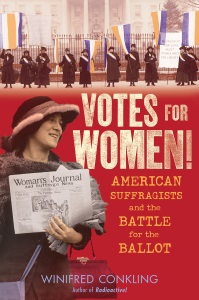Five questions for Winifred Conkling
 In Votes for Women: American Suffragists and the Battle for the Ballot (Algonquin, 12 years and up), Winifred Conkling explores the history of the U.S. suffrage movement, beginning with the Women’s Rights Convention in 1848 and culminating with ratification of the Nineteenth Amendment over seventy years later. She focuses on major figures in the movement — notably Susan B. Anthony, Elizabeth Cady Stanton, and Alice Paul — and doesn’t shy away from lesser-discussed (and often ignored) realities surrounding the abolition movement and racism.
In Votes for Women: American Suffragists and the Battle for the Ballot (Algonquin, 12 years and up), Winifred Conkling explores the history of the U.S. suffrage movement, beginning with the Women’s Rights Convention in 1848 and culminating with ratification of the Nineteenth Amendment over seventy years later. She focuses on major figures in the movement — notably Susan B. Anthony, Elizabeth Cady Stanton, and Alice Paul — and doesn’t shy away from lesser-discussed (and often ignored) realities surrounding the abolition movement and racism.
1. As I was reading Votes for Women, I was struck by how similar our contemporary conversations about gender equality are to those from 170 years ago — and we are still fighting many of the same battles. How much of that was surprising to you?
WC: Same war, different battles. I was surprised by how prescient Elizabeth Cady Stanton’s words were in the Declaration of Sentiments. In 1848, she rewrote the Declaration of Independence, boldly stating that all men and women are created equal. She made that radical argument — the core of feminism — at a time when women had very few legal rights. Today, women have secured basic freedoms, although they are still fighting for equal pay, reproductive rights, and workplaces free of sexual harassment, among other issues. There’s no doubt that we have made a lot of progress in 170 years, but it’s also obvious that there’s more work to be done. Many people feel uncomfortable with the term “feminist,” but it means the same thing today that it did in 1848 — equality of the sexes — nothing more, nothing less.
2. You’re very honest in your presentation of racism within the suffrage movement (also resonant today). Why was this important for you to acknowledge?
WC: Like it or not, the women’s movement was divided by racism in the nineteenth century. The issue needs to be openly discussed because it happened. It’s also important that young readers learn to appreciate their heroines as flawed and complex human beings. Elizabeth Cady Stanton and Susan B. Anthony did make some disturbingly racist and inflammatory comments, but both women also worked for decades to end slavery. They favored voting rights for African American men, just not at the expense of voting rights for women. It’s essential for people fighting for minority rights to realize that they are much more powerful when they work together than when they are divided by narrow self-interest. Imagine what might have happened if the movement had demanded universal suffrage for both women and African Americans.
 3. What do you think Elizabeth Cady Stanton would have thought of Hillary? Do you think she would have been with her?
3. What do you think Elizabeth Cady Stanton would have thought of Hillary? Do you think she would have been with her?
WC: I think Elizabeth Cady Stanton would have voted Hillary 2016 (although she might have backed Bernie in the primary). While Stanton would have been delighted with a female president, I think she would have backed Hillary because she offered a more progressive agenda than her Republican opponent. I can’t help but think Stanton would have been pro-choice (she lectured on reproductive rights and birth control in the 19th century), and I think she would have had a lot to say about voting suppression laws and campaign-finance reform. If Stanton were alive today, maybe she would run for office herself: Stanton 2020.
4. Do you have a favorite suffragist?
WC: If you’re going to force me to pick, I’ll have to go with Alice Paul. She was “The Closer” for the women’s suffrage movement, turning up the public pressure on President Wilson until he changed his position on women’s suffrage. She lived her mission, putting herself at risk to support her beliefs. Gagging while being force-fed cold milk and raw eggs in jail is the stuff of nightmares, but she willingly endured this torture (three times a day) to support her beliefs. I admire her stubborn passion and militancy.
5. What advice do you think our foremothers would have for young activists today?
WC: Stay strong. The first women’s rights convention was held in Seneca Falls, New York in 1848. Women didn’t get the right to vote until 1920. Change takes sustained effort over a long period of time. I would love to see young activists bring back the Silent Sentinel campaign. Can you imagine the impact if the youth in the gun control movement made flags with the names and faces of students killed in school shootings and silently marched in front of the Capitol? That’s where the patience comes in. They would need to march day in and day out as long as it takes. The suffrage movement demonstrates the power of public pressure to change the hearts and minds of lawmakers. Sign me up — I’ll take a shift.
From the March 2018 issue of Notes from the Horn Book.

RELATED
ALREADY A SUBSCRIBER? LOG IN
We are currently offering this content for free. Sign up now to activate your personal profile, where you can save articles for future viewing.







Add Comment :-
Be the first reader to comment.
Comment Policy: